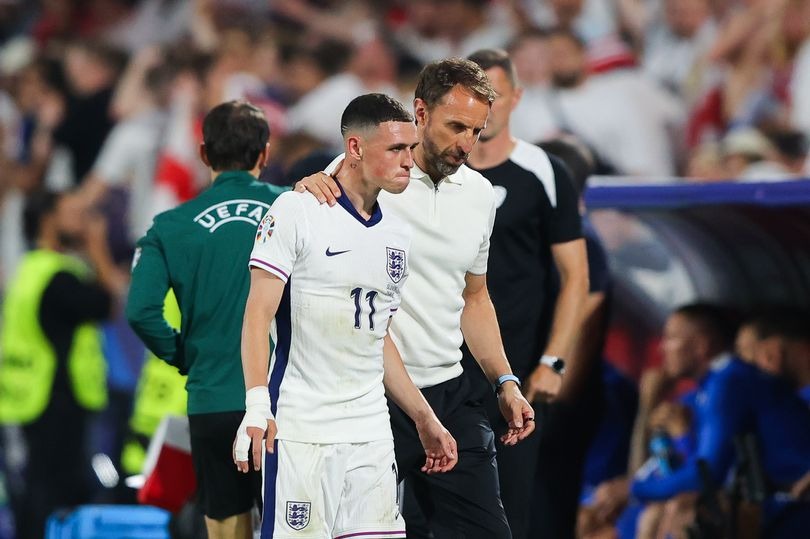Phil Foden’s performances are getting plenty of scrutiny this month at Euro 2024, as a lacklustre England struggle for a system that gets the best out of their talented players.

Gareth Southgate and Phil Foden (Image: Getty)
“The key for Phil is where he ends up, not his starting position,” said Gareth Southgate in May, hoping to end months of debate over Phil Foden’s position heading into Euro 2024.
How is that going, Gareth?
A third sluggish England performance saw the Three Lions somehow stumble into the knockout stages of the Euros as group winners, but the frustration is rife from the stands and in the TV studios. Much of the debate is predictably focused around Foden – how can a player so destructive for Manchester City last season be nullified by England so quickly?
For Southgate to truly get the best out of Foden, he needs to take a leaf out of Pep Guardiola’s playbook, and not by saying simple things like the above quote. It’s all well and good pointing out that Foden can be effective coming inside from the wing, but he needs the support from his manager to be effective in the middle when he does that.
At City, Foden has similar hurdles to becoming a No.10 as he does with England. Kevin De Bruyne is City’s No.10 as long as he’s at the Etihad, and it’s fair for Southgate to play La Liga Player of the Season Jude Bellingham at the top of midfield as that is his best position. That means Foden can’t always be in his preferred position, yet Bellingham hasn’t helped Foden like De Bruyne does.
With De Bruyne injured last season, Foden got the minutes he wanted at No.10 – either as an out-and-out attacking midfielder or as a winger coming inside. He showed his game-changing prowess on his own in that role, and later continued to be effective when coming off either flank, so why is he not making those same impacts for England?
For a start, when coming inside, Foden has either De Bruyne or Bernardo Silva to rotate with, or sometimes Julian Alvarez. Those players know when to cover Foden’s position, move slightly wide to create a dual No.10 system or drop deeper as the formation adapts. Also key to the system working was Kyle Walker when Foden started on the right.
Walker spent most of his time during those games bombing up and down the right, effectively playing as a touchline-hugging winger to allow Foden the space to attack the inside channels alongside a designated No.10. As the season progressed and Foden moved over to the left, it was Josko Gvardiol offering the width, overlapping and underlapping to play off Foden (and score some goals himself).
At the Euros, Foden is stuck out on the left with a right-footed left-back who refuses to go on the overlap or even advance to within ten yards of Foden. His frustration at Kieran Trippier was obvious against Slovenia, and it was little surprise that Foden looked more effective when swapping with Bellingham at No.10 or when Walker switched to the left. Foden needs his opposite full-back occupied with two or three players, not just a one-on-one battle that is harder to win.
With Walker and John Stones in the line-up, there is a back-line fully capable of switching to a three when one advances. There are all the ingredients and similar players to replicate the City system, but a stubbornness not to. As Wayne Rooney said: England are playing like City without the timing or tact.
Foden also gets the space he does to play at City because Erling Haaland is constantly on the shoulder of the defender, stretching the opposition defensive and midfield lines. Harry Kane is a No.9 of the opposite mould – consistently dropping deep in the exact positions Foden would want to drive into, and then not being where Foden would naturally look for his striker. Kane is best when finishing in the box, so why doesn’t he stay there and let his younger colleagues create for him?
If Southgate wants to get the best out of Foden, he will have seen the Premier League Player of the Season play across the front line rather than be shackled to the left. He needs the support of a willing full-back, striker and No.10, and he currently has none of that.
Guardiola even got joy out of Foden as a No.8 at times last season, particularly in the Champions League. It is a puzzle to see one of the most adaptable forwards in world football so restricted by his manager’s tactics, especially when the solution seems so obvious.
Southgate is right – Foden’s starting position shouldn’t matter. But the system and set-up he is in absolutely does.
